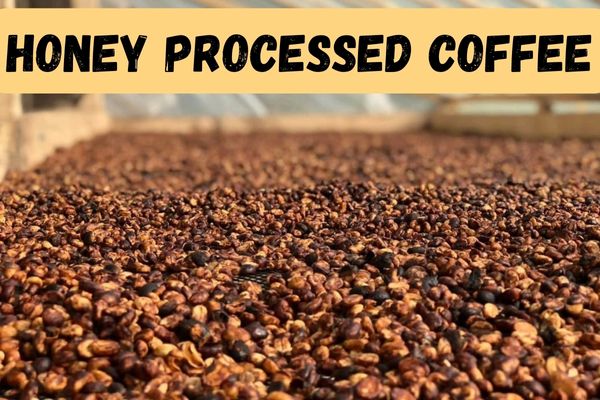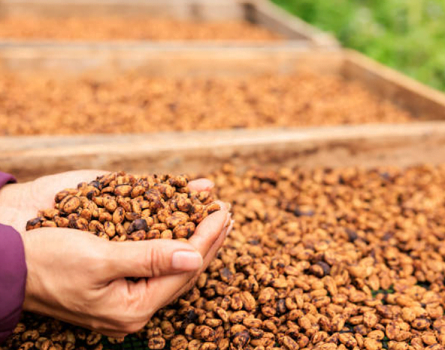The Honey Coffee Process is an innovative new way to process coffee beans. It is only been around for about a decade but has gained massive popularity in recent years.
Key Takeaways
- Honey processed coffee is a hybrid of washed and natural processing that leaves some mucilage on the beans.
- The amount of mucilage left after depulping determines the type of honey process
- Precise control over mucilage removal and drying is critical

What is Honey Processed Coffee?
Honey-processed coffee is a unique method of processing coffee beans. After harvesting, cherries are de-pulped but not washed thoroughly. The beans are left to dry with their sugary mucilage coating, which gives them a sweet, honey-like flavor.
It is called honey process because of the sticky mucilage layer that resembles honey. The sugars in the mucilage caramelize during drying, enhancing the beans’ inherent flavors.
The Honey Process is almost similar to the Pulp Natural process used in Brazil and the Wet Hulling method used in Indonesia.
This labor-intensive process originated in Costa Rica but is gaining popularity worldwide.
Here’s what the honey process looks like
- After harvesting, the cherries first go through a depulper which removes the outer skin but leaves some of that sticky, sweet mucilage still clinging to the beans. The depulper can be adjusted to control how much mucilage stays on.
- Next, the beans are set out to dry in the sun for about 6-8 days. During this time, farmers will periodically mix up the beans to make sure they dry evenly. It’s important not to let them over-ferment and get moldy!
- Once fully dried, the beans head to the dry mill which finishes the job by removing any leftover fruit or mucilage, leaving you with clean, honey-processed coffee beans ready for roasting.
As an Amazon Associate, I earn commission from qualifying purchases.
Types of Honey Process Coffee
The amount of mucilage remaining after de-pulping is the key factor in determining the type of honey process and the end flavor.

1. White Honey Processing
In the white Honey Process almost all the mucilage is removed, leaving just a thin layer. They dry faster and end up with a light color. The flavor is smooth and clean, similar to a washed coffee.
2. Yellow Honey Processing
In Yellow Honey Processing medium layer of mucilage remains after depulping, around 25%. The beans gain a yellowish tone during drying because of oxidation.
3. Red Honey Processing
In Red Honey Processing about half (50%) of the mucilage stays on the beans. They’re dried more slowly, mostly under the shade, and the color oxidizes into a red tone during the process.
4. Black Honey Processing
In Black Honey Processing almost all the mucilage stays on the beans after depulping. The beans are dried very slowly under a shade to really extend the process. The mucilage layer becomes super thick and darkens to an almost black color. It’s risky as the longer drying time increases the chances of over-fermentation and bacterial defects.
In general, the more mucilage remains, the slower the drying time and darker the end color. The flavors also get more intense, with black honey being bold and fruity like a natural coffee.
So, the honey process is all about producers finding the perfect balance between clean and fruity by controlling mucilage removal and drying duration.
How is Honey Processed Coffee different from Washed or Natural Process?
Honey processed coffee is like a hybrid between washed and natural coffee. The two of the most common processing methods.
In the washed coffee process, they remove all of the fruit and mucilage from the beans before drying them. This creates a really clean, bright, crisp flavor.
In the Natural Coffee process, beans are dried inside the fruit without removing anything. This gives them a super sweet, fruity taste.
Honey processing is right in the middle – they get rid of the outer skin of the cherry but leave that sticky, honey-like mucilage layer on the beans to dry.

Read a guide on Washed vs Natural Coffee
The Flavor Profile of Honey Processed Coffee
Honey-processed coffees taste more complex than washed coffees, with some extra sugars, but they’re not as overtly fruity as natural coffees.
Depending on how much mucilage is left on the beans during processing, you’ll get different flavor profiles – from a washed coffee-like clean taste to a natural coffee-like super sweet and fruity flavor.
Honey Coffee is generally less acidic and has a balanced sweetness that works perfectly with drip brew methods.
I have tried Costa Rican honey processed coffee and it was amazing!
Costa Rica has perfected this method and produces some of the best honey-processed coffees out there!
A honey-processed Panamanian Geisha recently fetched the highest price ever at auction, selling for a whopping $6034 per pound!
What makes Honey Processed Coffee Special
The thing that really makes honey processed coffee special is you get this juicy, complex flavor profile along with brightness and crispness.
Another benefit of the honey process is that the beans can be less susceptible to over-fermentation or growing mold than natural processed coffees.
The honey process also uses less water than fully washed coffees, which is a nice sustainability advantage in countries where water is already scarce.
The drawback is that honey processing requires expert skill and labor from producers thus increasing the production cost. The producers have to be super precise with how much mucilage they leave on the beans, constantly turning them while they dry. It’s easy to mess up at any stage.
Final Thoughts
I’d love to hear which honey coffees you’ve tried and how you’d describe the taste.
With so many possible variations in mucilage removal, drying time, and bean origin, there’s still so much for coffee explorers like us to discover with the honey coffee process.
Check out other interesting articles related to beans:




I had a chance to try Honey Processed Coffee from Costa Rica. It has fruity notes with a very balanced flavor profile. I loved it!
That’s awesome! Honey processed coffee from Costa Rica seems amazing. Glad you enjoyed it!